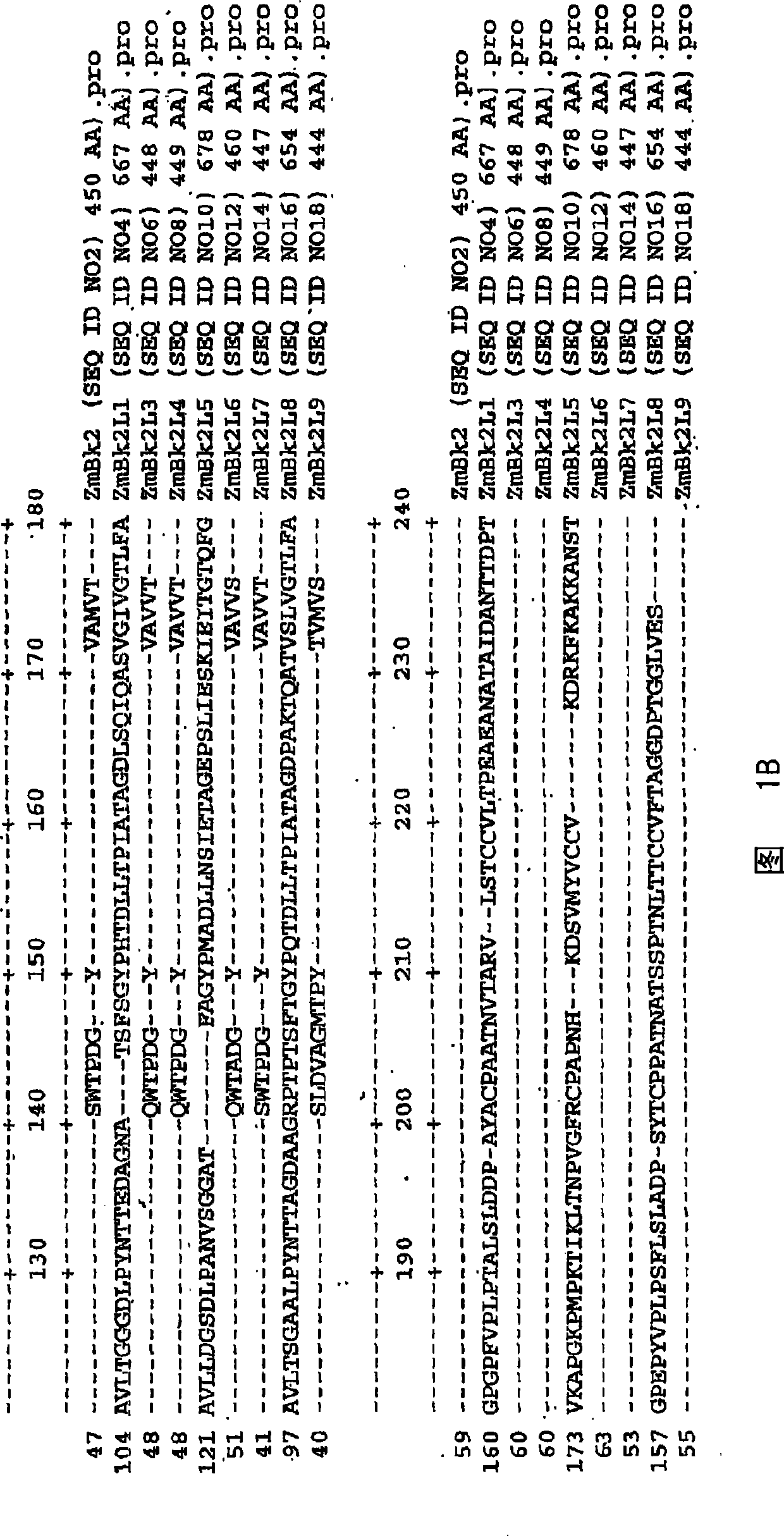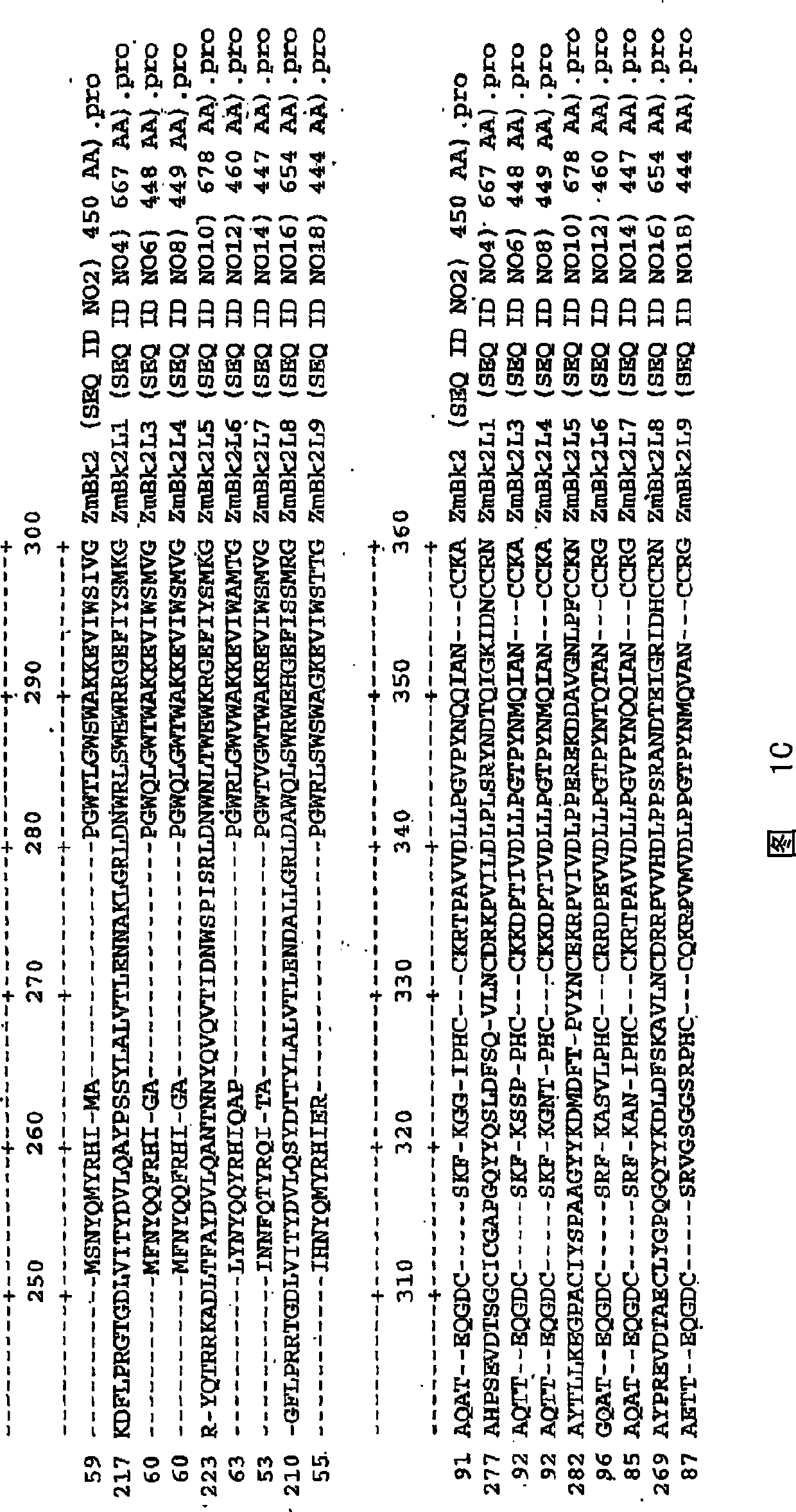Crisp caudex 2 gene family and correlation method and purpose
A genome and transgenic plant technology, applied in the field of plant molecular biology, can solve problems such as collapse and reduce mechanical strength
- Summary
- Abstract
- Description
- Claims
- Application Information
AI Technical Summary
Problems solved by technology
Method used
Image
Examples
Embodiment 1
[0223] Characterization of maize cDNA encoding Bk2-like protein
[0224]The corn crispy stem 2 (bk2) phenotype was first reported in 1940 (Langham, MNL 14:21-22 (1940)) by phenotype mapping chr9L between the markers umc95 and bn17.13 around the 100 centimorgan region (Howell et al., MNL 65:52-53 (1991 )). Previously, clone csc1c.pk005.k4:fis (SEQ ID NO: 1) was confirmed to encode the fragile stem 2 polypeptide (SEQ ID NO: 2) (International Application No. PCT / US2005 / 035450, which claims to be filed on October 6, 2004 priority of U.S. Provisional Application No. 60 / 615,868, the entire contents of which are incorporated herein by reference). Two additional members of the Bk2 gene family are also disclosed (SEQ ID NO: 7 and 8 and SEQ ID NO: 13 and 14). In this disclosure, these genes have been named Bk2-like (Bk2L).
[0225] Using the BLASTN or TBLASTN algorithm provided by the National Center for Biotechnology Information (NCBI), several databases were searched for other ma...
Embodiment 2
[0236] Gene expression analysis of Bk2-like proteins
[0237] Massively Parallel Signal Sequencing (MPSS) using Solexa TM ) technology (see Table 3) (Brenner et al., Nat.Biotechnol.18:630-634 (2000); Brenner et al., Proc.Natl.Acad.Sci.U.S.A.97:1665-1670 (2000)), checked Tissue specificity of expression of the Bk2-like gene family disclosed in Table 1. MPSS TM Contains a 17-base signaling flag established from an mRNA sample that has been reverse transcribed. The markers are sequenced simultaneously and assigned to genes or ESTs. Numerical values normalized to parts per million (PPM) are given for the abundance of these markers and then compared for marker expression or marker abundance between different tissues. Therefore, MPSS TM The platform can be used to determine the expression pattern of a specific gene, and its expression level in different tissues. Numbers are averages of multiple libraries per tissue listed in the second column.
[0238] table 3
[0239]...
Embodiment 3
[0249] prophetic embodiment
[0250] By overexpressing a maize Bk2-like gene under the control of a strong stem-specific promoter, a Builds enhanced stem strength
[0251] Construct chimeric transgenes to directly overexpress Bk2 gene / polypeptide in a tissue-specific manner. The transgenic construct comprises a maize cDNA encoding Bk2L3 and / or Bk2L6 (e.g., SEQ ID NO:5 or SEQ ID NO:11) operably linked to the promoter of the stem-specific S2A gene from alfalfa (Abrahams et al. Human, Plant Mol. Biol. 27:513-528 (1995)). DNA containing the Bk2L3 or Bk2L6 ORF was then fused to the S2A promoter on the 5' end and the pinII terminator on the 3' end to generate image 3Expression cassettes indicated. The construct was then ligated to a selection marker cassette containing the CaMV 35S promoter driven bar gene and pinll terminator. Those skilled in the art will appreciate that different promoters, 5' end sequences and / or 3' end sequences can be used to achieve comparable expr...
PUM
 Login to View More
Login to View More Abstract
Description
Claims
Application Information
 Login to View More
Login to View More - R&D Engineer
- R&D Manager
- IP Professional
- Industry Leading Data Capabilities
- Powerful AI technology
- Patent DNA Extraction
Browse by: Latest US Patents, China's latest patents, Technical Efficacy Thesaurus, Application Domain, Technology Topic, Popular Technical Reports.
© 2024 PatSnap. All rights reserved.Legal|Privacy policy|Modern Slavery Act Transparency Statement|Sitemap|About US| Contact US: help@patsnap.com










